|
Allison J35-A-21A
The General Electric/Allison J35 was the United States Air Force's first axial-flow (straight-through airflow) compressor jet engine. Originally developed by General Electric (GE company designation TG-180) in parallel with the Whittle-based centrifugal-flow J33, the J35 was a fairly simple turbojet, consisting of an eleven-stage axial-flow compressor and a single-stage turbine. With the afterburner, which most models carried, it produced a thrust of . Like the J33, the design of the J35 originated at General Electric, but major production was by the Allison Engine Company. Design and development While developing the T31 axial turboprop in 1943 General Electric realized that they had the resources to design an axial flow turbojet at the same time as their centrifugal-flow J33 engine. They recognized the axial would have more potential for the future and went ahead with the TG-180 engine. GE axial compressor designs were developed from the NACA 8-stage compressor. The engi ... [...More Info...] [...Related Items...] OR: [Wikipedia] [Google] [Baidu] |
WikiProject Aircraft
A WikiProject, or Wikiproject, is a Wikimedia movement affinity group for contributors with shared goals. WikiProjects are prevalent within the largest wiki, Wikipedia, and exist to varying degrees within sister projects such as Wiktionary, Wikiquote, Wikidata, and Wikisource. They also exist in different languages, and translation of articles is a form of their collaboration. During the COVID-19 pandemic, CBS News noted the role of Wikipedia's WikiProject Medicine in maintaining the accuracy of articles related to the disease. Another WikiProject that has drawn attention is WikiProject Women Scientists, which was profiled by '' Smithsonian'' for its efforts to improve coverage of women scientists which the profile noted had "helped increase the number of female scientists on Wikipedia from around 1,600 to over 5,000". On Wikipedia Some Wikipedia WikiProjects are substantial enough to engage in cooperative activities with outside organizations relevant to the field at issue. For e ... [...More Info...] [...Related Items...] OR: [Wikipedia] [Google] [Baidu] |
Allison J33
The General Electric/Allison J33 is a development of the General Electric J31, enlarged to produce significantly greater thrust, starting at and ending at with an additional low-altitude boost to with water-alcohol injection. Development The J33 was originally developed by General Electric as a follow-on to their work with the designs of Frank Whittle during World War II. Their first engine was known as the General Electric I-A, but after major changes to adapt it to US production and to increase thrust, it started limited production as the I-16 in 1942, the 16 referring to its thrust. Full production started as the J31 when the United States Army Air Forces introduced common naming for all their engine projects. Along with the I-16, GE also started work on an enlarged version, known as the I-40. As the name implied, the engine was designed to provide . Apart from size, the main difference between I-16 and the I-40 was the combustion system: the I-16 had ten reverse-flow c ... [...More Info...] [...Related Items...] OR: [Wikipedia] [Google] [Baidu] |
Republic XP-84 Thunderjet
The Republic F-84 Thunderjet was an American turbojet fighter-bomber aircraft. Originating as a 1944 United States Army Air Forces (USAAF) proposal for a "day fighter", the F-84 first flew in 1946. Although it entered service in 1947, the Thunderjet was plagued by so many structural and engine problems that a 1948 U.S. Air Force review declared it unable to execute any aspect of its intended mission and considered canceling the program. The aircraft was not considered fully operational until the 1949 F-84D model and the design matured only with the definitive F-84G introduced in 1951. In 1954, the straight-wing Thunderjet was joined by the swept-wing F-84F Thunderstreak fighter and RF-84F Thunderflash photo reconnaissance aircraft. The Thunderjet became the USAF's primary strike aircraft during the Korean War, flying 86,408 sorties and destroying 60% of all ground targets in the war as well as eight Soviet-built MiG fighters. Over half of the 7,524 F-84s produced served with N ... [...More Info...] [...Related Items...] OR: [Wikipedia] [Google] [Baidu] |
General Electric J73
The General Electric J73 turbojet was developed by General Electric from the earlier J47 engine. Its original USAF designation was J47-21, but with innovative features including variable inlet guide vanes, double-shell (inner and outer) combustor case, and 50% greater airflow was redesignated J73. Its only operational use was in the North American F-86H. Design and development An engine, uprated from the J47, was required for the F-86H. The mass flow was increased by relocating accessories from the centre of the compressor inlet to the underside of the engine. This allowed a reduction in blade hub diameter, which together with an increase in tip diameter, gave a bigger area for air to enter the compressor. The area through the combustion chambers also had to be increased. This was done by replacing the multiple individual chambers with a single annular casing with individual flame tubes or cans known as cannular. The pressure ratio was increased and variable inlet guide vanes ... [...More Info...] [...Related Items...] OR: [Wikipedia] [Google] [Baidu] |
Aircraft Engine Starting
Many variations of aircraft engine starting have been used since the Wright brothers made their first powered flight in 1903. The methods used have been designed for weight saving, simplicity of operation and reliability. Early piston engines were started by hand, with geared hand starting, electrical and cartridge-operated systems for larger engines being developed between the wars. Gas turbine aircraft engines such as turbojets, turboshafts and turbofans often use air/pneumatic starting, with the use of ''bleed air'' from built-in auxiliary power units (APUs) or external air compressors now seen as a common starting method. Often only one engine needs be started using the APU (or remote compressor). After the first engine is started using APU bleed air, ''cross-bleed air'' from the running engine can be used to start the remaining engine(s). Piston engines Hand starting/propeller swinging Hand starting of aircraft piston engines by swinging the propeller is the oldest and sim ... [...More Info...] [...Related Items...] OR: [Wikipedia] [Google] [Baidu] |
National Advisory Committee For Aeronautics
The National Advisory Committee for Aeronautics (NACA) was a United States federal agency founded on March 3, 1915, to undertake, promote, and institutionalize aeronautical research. On October 1, 1958, the agency was dissolved and its assets and personnel were transferred to the newly created National Aeronautics and Space Administration (NASA). NACA is an initialism, i.e., pronounced as individual letters, rather than as a whole word (as was NASA during the early years after being established). Among other advancements, NACA research and development produced the NACA duct, a type of air intake used in modern automotive applications, the NACA cowling, and several series of NACA airfoils, which are still used in aircraft manufacturing. During World War II, NACA was described as "The Force Behind Our Air Supremacy" due to its key role in producing working superchargers for high altitude bombers, and for producing the laminar wing profiles for the North American P-51 Mustang. NA ... [...More Info...] [...Related Items...] OR: [Wikipedia] [Google] [Baidu] |
Axial Flow
An axial compressor is a gas compressor that can continuously pressurize gases. It is a rotating, airfoil-based compressor in which the gas or working fluid principally flows parallel to the axis of rotation, or axially. This differs from other rotating compressors such as centrifugal compressor, axi-centrifugal compressors and mixed-flow compressors where the fluid flow will include a "radial component" through the compressor. The energy level of the fluid increases as it flows through the compressor due to the action of the rotor blades which exert a torque on the fluid. The stationary blades slow the fluid, converting the circumferential component of flow into pressure. Compressors are typically driven by an electric motor or a steam or a gas turbine. Axial flow compressors produce a continuous flow of compressed gas, and have the benefits of high efficiency and large mass flow rate, particularly in relation to their size and cross-section. They do, however, require seve ... [...More Info...] [...Related Items...] OR: [Wikipedia] [Google] [Baidu] |
General Electric
General Electric Company (GE) is an American multinational conglomerate founded in 1892, and incorporated in New York state and headquartered in Boston. The company operated in sectors including healthcare, aviation, power, renewable energy, digital industry, additive manufacturing and venture capital and finance, but has since divested from several areas, now primarily consisting of the first four segments. In 2020, GE ranked among the Fortune 500 as the 33rd largest firm in the United States by gross revenue. In 2011, GE ranked among the Fortune 20 as the 14th most profitable company, but later very severely underperformed the market (by about 75%) as its profitability collapsed. Two employees of GE – Irving Langmuir (1932) and Ivar Giaever (1973) – have been awarded the Nobel Prize. On November 9, 2021, the company announced it would divide itself into three investment-grade public companies. On July 18, 2022, GE unveiled the brand names of the companies it will ... [...More Info...] [...Related Items...] OR: [Wikipedia] [Google] [Baidu] |
Turboprop
A turboprop is a turbine engine that drives an aircraft propeller. A turboprop consists of an intake, reduction gearbox, compressor, combustor, turbine, and a propelling nozzle. Air enters the intake and is compressed by the compressor. Fuel is then added to the compressed air in the combustor, where the fuel-air mixture then combusts. The hot combustion gases expand through the turbine stages, generating power at the point of exhaust. Some of the power generated by the turbine is used to drive the compressor and electric generator. The gases are then exhausted from the turbine. In contrast to a turbojet or turbofan, the engine's exhaust gases do not provide enough energy to create significant thrust, since almost all of the engine's power is used to drive the propeller. Technological aspects Exhaust thrust in a turboprop is sacrificed in favor of shaft power, which is obtained by extracting additional power (beyond that necessary to drive the compressor) from turbine ex ... [...More Info...] [...Related Items...] OR: [Wikipedia] [Google] [Baidu] |





